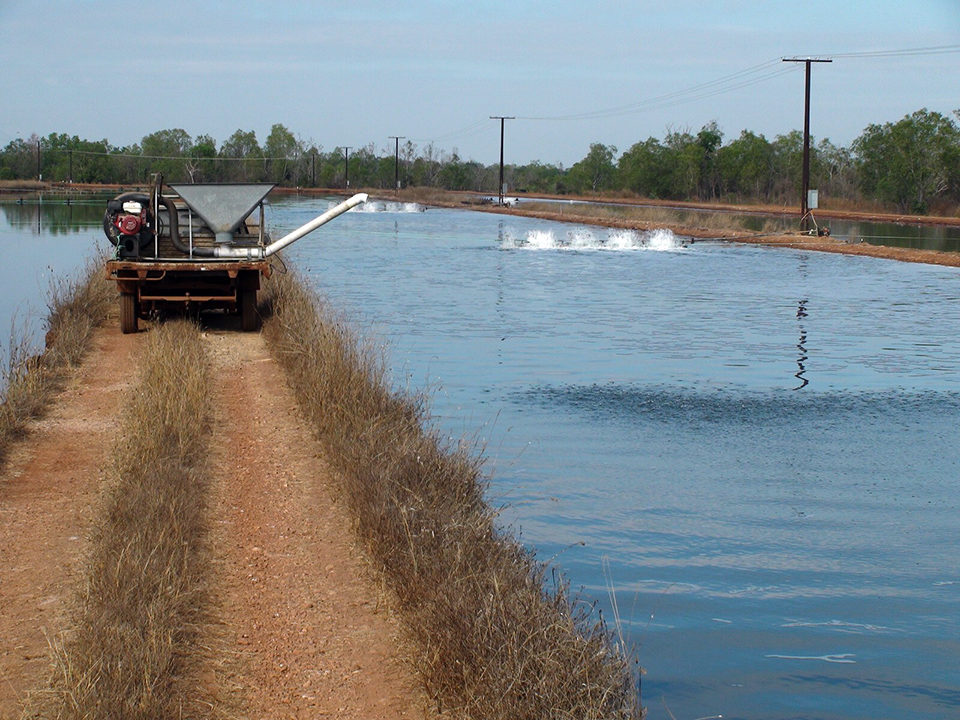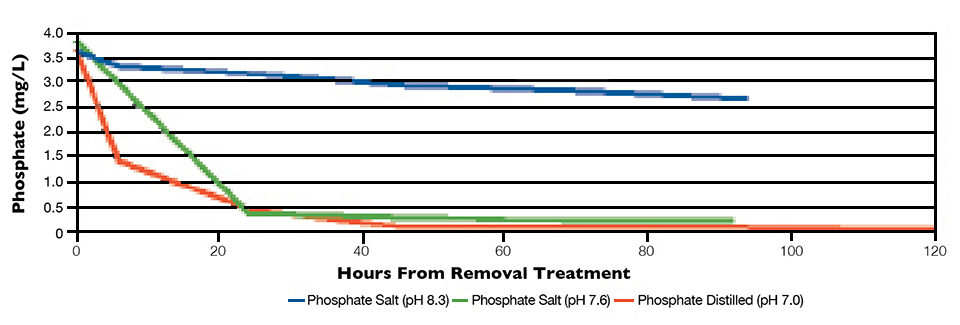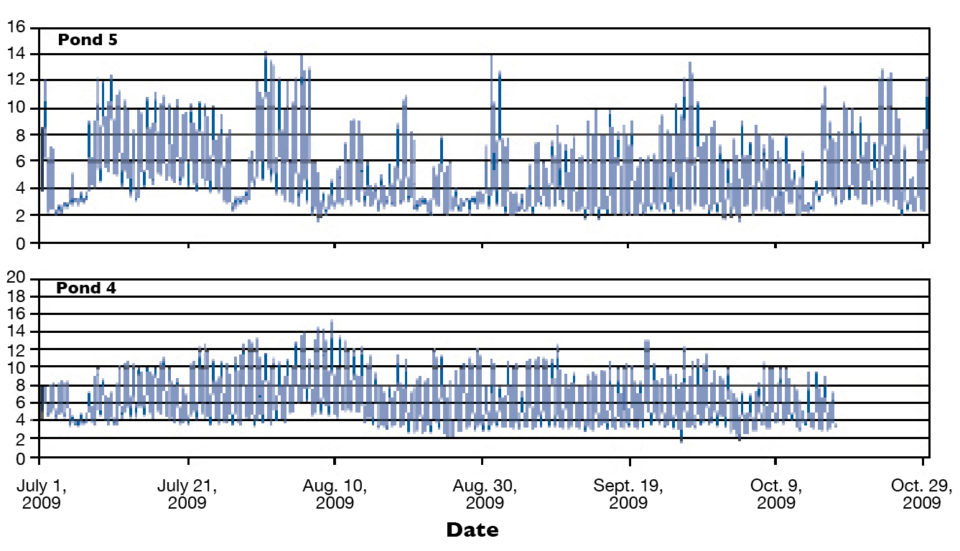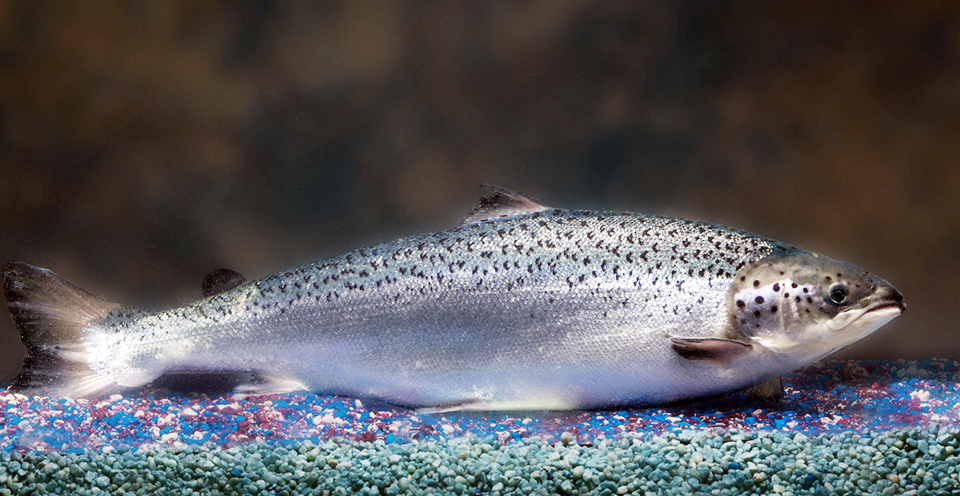Protocols now center on pH and phosphate

As environmental regulations and buyers’ requirements continue to tighten, and knowledge about disease risks and harmful algae continues to accumulate, farmers are looking for means other than water exchange to manage their ponds. Reduction of phosphate may be a useful way to help gain control over algal blooms in eutrophic aquaculture ponds, where minimal water exchange is desired.
In investigating the response of farm ponds to limited phosphate, the author has found that limitation of phosphate without controlling pH does little to increase the degree of control over algal blooms. However, when phosphate and pH are controlled together, a significant level of control can be achieved.
Farm testing
The author’s farm is situated near Darwin in the Northern Territory of Australia. The 14-hectare farm currently grows barramundi in saltwater ponds. The climate is tropical with distinct wet and dry seasons. Early morning pond water temperatures and salinities range from 24 to 32 degrees C and 10 to 36 ppt.
In June 2009, the farm experienced a bloom of the toxic algae Prymnesium parvum, which killed all the fish in the affected pond. Prof. Gustaaf Hallegraeff, an expert in harmful algae from the University of Tasmania, was called in to help the farm staff understand what measures could prevent another outbreak. He suggested a review of the nitrogen:phorphorus ratios in the ponds.
This led the author to Phoslock, a company that manufactures and markets a product that removes phosphate from water. After checking the environmental credentials of the product, trial results were erratic, but application of the product did remove phosphate.
The erratic nature of the reponses led to a number of questions. One of these examined the effects of limited phosphate on alkaline phosphatase. This enzyme liberates phosphate from a large range of organic molecules. The liberated phosphate is then available to algae.
Were the ponds producing alkaline phosphatase? Subsequent measurements did indeed show strong phosphatase production in phosphate-limited ponds.
Algae control
Early in the investigations, the differences observed in phosphate-limited ponds were not as high as hoped. To be fair, there was a very positive outcome in terms of Prymnesium, which has not been seen in significant numbers since phosphate has been kept under 0.05 mg/L. However, other nuisance species still grew and often bloomed in low-phosphate ponds.
These results suggested that the whole concept of controlling phosphate in aquaculture ponds was going to be costly. In addition, nature had its own way of getting around our interfering ways, for example, by producing more phosphatase enzyme – which could liberate phosphate as quickly as it could be mopped up with phosphate-removal treatments.
Lab testing
In parallel with the field pond trials, the author conducted numerous bench tests to figure out the dynamics of the phosphate treatment in saltwater. From these tests, it became clear that in seawater, pH had a strong effect on the effectiveness of the product (Fig. 1). But was this the whole story? Is alkaline phosphatase more active in elevated pH?

Results showed clearly that this is indeed the case. Given this, plus the greatly increased effectiveness of the phosphate treatment in lower-pH seawater, work began to lower the pH in the farm ponds.
Molasses drops pH
Some years ago, the author did quite a lot of work with molasses on his farm, but suspended it when the cost of aeration and associated risk of depressed dissolved-oxygen levels exceeded the benefits. Nevertheless, the experience taught that adding molasses resulted in a drop in pH. So molasses was applied to the ponds to gradually lower pH under 7.7, the level bench tests indicated was most effective for removal of phosphate by Phoslock.
Once pH declined and phosphate levels were under 0.03 mg/L, the ponds settled into a predictable and safe rhythm. With phosphate kept low, aeration costs did not increase as they had previously and may in fact have decreased. The green nano-chlorella bloom that dominates this environment includes tiny flagellates and diatoms. Dissolved-oxygen levels are stable and there seems little risk of the crashes experienced in previous phosphate-rich blooms (Fig. 2).

Pond management
Pond management protocols now center on pH and phosphate. If pH breaches 7.7, molasses is applied. If the molasses application is delayed, the pond can quickly jump out of control, and other nuisance or dangerous blooms can develop. Diligent monitoring of pH and subsequent application of molasses can readily control pH. Likewise with phosphate – as long as phosphate levels are suppressed, bloom volatility is suppressed.
Alkaline phosphatase is still present in this low-pH environment in substantial quantities, but its activity is slowed at lower pH. These results confirmed observations that in low-pH ponds, phosphate stays low for extended periods, meaning treatments are only rarely applied. Phosphate appears much more quickly due to increased enzyme activity in ponds with elevated pH.
For farmers, the ability to maintain algal blooms that are predictable, stable and safe is of immense benefit. It allows straightforward pond management protocols that relatively inexperienced staff can follow. And, as many pond farmers can appreciate, stable ponds mean less sleepless nights.
(Editor’s Note: This article was originally published in the November/December 2010 print edition of the Global Aquaculture Advocate.)
Now that you've reached the end of the article ...
… please consider supporting GSA’s mission to advance responsible seafood practices through education, advocacy and third-party assurances. The Advocate aims to document the evolution of responsible seafood practices and share the expansive knowledge of our vast network of contributors.
By becoming a Global Seafood Alliance member, you’re ensuring that all of the pre-competitive work we do through member benefits, resources and events can continue. Individual membership costs just $50 a year.
Not a GSA member? Join us.
Author
-
Adam Body
ARDA-Tek Farm
P.O. Box 39346
Winnellie, Northern Territory, Australia 0821[109,111,99,46,100,110,111,112,103,105,98,64,121,100,111,98,109,97,100,97]
Tagged With
Related Posts

Responsibility
A look at integrated multi-trophic aquaculture
In integrated multi-trophic aquaculture, farmers combine the cultivation of fed species such as finfish or shrimp with extractive seaweeds, aquatic plants and shellfish and other invertebrates that recapture organic and inorganic particulate nutrients for their growth.

Aquafeeds
A look at phospholipids in aquafeeds
Phospholipids are the major constituents of cell membranes and are vital to the normal function of every cell and organ. The inclusion of phospholipids in aquafeeds ensures increased growth, better survival and stress resistance, and prevention of skeletal deformities of larval and juvenile stages of fish and shellfish species.

Health & Welfare
10 paths to low productivity and profitability with tilapia in sub-Saharan Africa
Tilapia culture in sub-Saharan Africa suffers from low productivity and profitability. A comprehensive management approach is needed to address the root causes.

Intelligence
A brief look at genetically modified salmon
If approved by FDA, fast-growing genetically modified salmon will provide a safe and nutritious product similar to other farmed Atlantic salmon.


